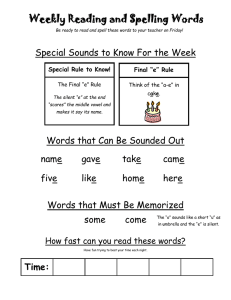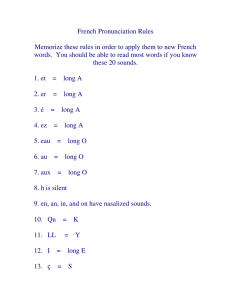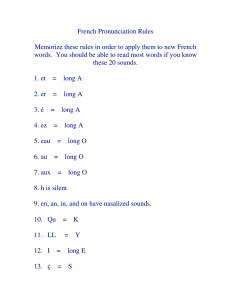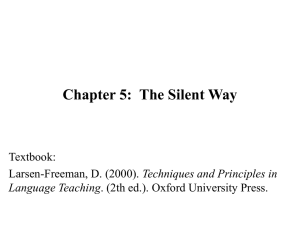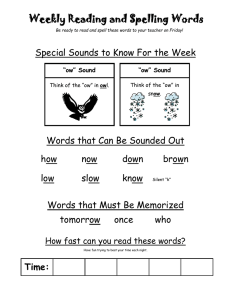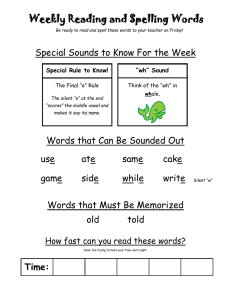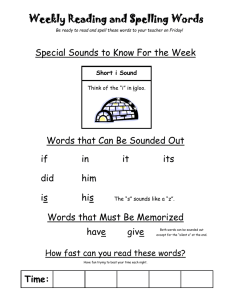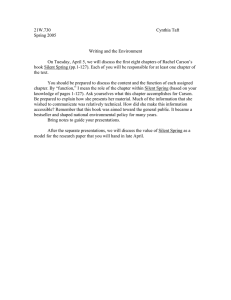CHAPTER 5: THE SILENT WAY Textbook: Techniques and Principles in Language Teaching
advertisement
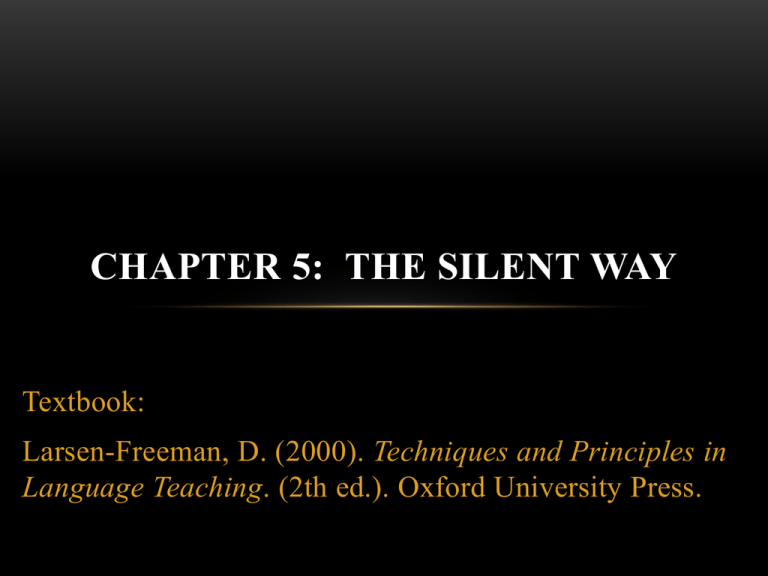
CHAPTER 5: THE SILENT WAY Textbook: Larsen-Freeman, D. (2000). Techniques and Principles in Language Teaching. (2th ed.). Oxford University Press. INTRODUCTION • The universal opinion of learning languages People learn languages by means of the Audio-Lingual Method. Learning a language means forming a set of habits. • The different opinion of linguist Noam Chomsky Speakers have a knowledge of underlying abstract rules, which allow them to understand and create novel utterances. Language is a product of rule formation. Language acquisition is a procedure whereby people use their own thinking processes, or cognition, to discover the language they are acquiring. INTRODUCTION • The Cognitive Approach Language learners were seen to be much more actively responsible for their own learning, and engaged in formulating hypotheses to discover the rules of the target language. CALEB GATTEGNO’S SILENT WAY The Silent Way it is based on the premise that the teacher should be silent as much as possible in the classroom and the learner should be encouraged to produce as much language as possible.” (Richards; ROGERS, 2007, p.81). Learning is a process which we initiate by ourselves by mobilizing our inner resources (perception, awareness, cognition, imagination, intuition, creativity) to meet challenge at hand. BASIC PRINCIPLE Teaching is to serve learning process rather than to dominate it. TEACHING METHODS & PRINCIPLES -1 1. The teacher remains silent and points to five blocks of color, which represent the sounds of five English vowels (/a/, /e/, /i/, /o/, /u/) close to the five simple vowels of Portuguese. • Principle1: Students are intelligent and learn the new language with their experience. The teacher should give help when necessary. TEACHING METHODS & PRINCIPLES -2 2. The teacher does not model the new sounds, but uses gestures to show the students how to modify the sounds. e.g. /e//ey/ Principle 2: Language is not learned by repeating a model. Students have to develop their inner criteria for correctness. TEACHING METHODS & PRINCIPLES -3 3.When some students cannot tap out and pronounce sounds correctly, the teacher just remains silent. The students have to help one another by themselves. Principle 3: Students can learn from one another. The teacher’s silence encourages group cooperation. TEACHING METHODS & PRINCIPLES -4 4. In the English class, the students have to learn actively. The teachers only remains silent and listens attentively. Principle 4: Teachers’ silence free them to closely observe the students’ behavior. And silence also helps foster autonomy. TEACHING METHODS & PRINCIPLES -5 5.When the students have trouble pronouncing new sounds and phrases, the teacher only uses gestures to point out students’ errors. Principle 5: If teachers praise or criticize students, they will be less self-reliant. Using gestures, teachers help point out the error for students. TEACHING METHODS & PRINCIPLES -6 6. After learning new sounds and phrases, some students choose to tap out simple commands; others tap out more complex ones. Principle 6: Language is for self-expression. TEACHING METHODS & PRINCIPLES -7 7. In the end of the class, the teacher asks the students for their reactions and comments to the lesson. Principle 7: The teacher can gain valuable information from the students’ feedback. TEACHING METHODS & PRINCIPLES -8 • 8. There is no homework assigned. Principle 8: Some learning takes place naturally as we sleep. Students will naturally work on the day’s lesson. ~REVIEW AND QUESTIONS~ 1.What are the goals of teachers who use the Silent Way? - self expression - developing the inner criteria for correctness 2. What is the role of the teacher? What is the role of the students? - The teacher play as a technician or engineer . guider, controller, facilitator, helper.. - Students’ role is active learners. - To use what they know - To free themselves any obstacles - To engage in exploring the language. 3. What are some characteristics of the teaching/ learning process? - Building up a whole set of sounds by sound-color chart -Teacher will give situation from which students can have a structure of language. - Practice of using a new language 4. What is the nature of student-teacher interaction? What is the nature of student-student interaction? The teacher has to remain silent. And students’ cooperation is important. 5. How are the feelings of the students dealt with? - Teachers are responsible to help students overcome the obstacles. - There will be a feedback session in the end of the class. 6. How is language viewed? How is culture viewed? -Each language has its unique feature. -Culture is always inseparable from language. 7. What areas of language are emphasized? What language skills are emphasized? - Sound: students have to acquire the melody of a language - Focus on the structures of a language -Vocabulary acquisition may be restricted -There is no fixed syllabus - Pronunciation - All four skills 8. What is the role of the students’ native language? The students’ native language can used to give instructions and help them with their pronunciation and perception. During feedback sessions To introduce new sounds in the target language. 9. How is evaluation accomplished? -Teachers rarely give test, so their observation on students’ learning process is important. -Teachers should not praise or criticize students. 10. How does the teacher respond to student errors? -Teachers work with students in getting them to selfcorrect. -If students cannot do it for themselves, teachers will aid them by supplying the correct answers. Techniques and Materials -Sound-color chart: The color chart can draw students’ attention. ~ remind Color chart can students what they learned and what they yet need to learn. -Teacher’s silence: The teacher gives help, and then is silent when the teacher is setting up a situation for language structure. For example: Tale a ___ rod. TECHNIQUES AND MATERIALS~ - Peer correction: • Students are encouraged to help another. Their relationship is based on cooperation, not competition. -RODS: • • • • Rods can be used to provide visible actions or situations for any language structure, to introduce it, or to enable students to practice using it. Rods are used to teach colors, numbers, and statements with prepositions and conditionals. Rods can be used abstractly as well. The teacher can use rods to represent each word in a sentence or to elicit the sentence from the students. CUISENAIRE RODS FOR STORY TELLING AND VOCABULARY -SELF-CORRECTION GESTURES • • The teacher put his palms together and then moved them outwards to signal to the students the need to lengthen the particular vowel. The teacher indicated that each of his fingers represented a word in a sentence and used this to locate the trouble spot for the student. -WORD CHART . There are twelve English charts containing about 500 words. The charts contain the functional vocabulary of English. • 2. The teacher points to words in word chart in a sequence to let students to read aloud the sentences. The way the letters are colored helps students with their pronunciation. • 1 -FIDEL CHARTS 1. There are eight Fidel charts for learning English. 2. The teacher, and later the students, point to the colorcoded Fidel charts in order that students associate the sounds of the language with their spelling. e.g. /ey/ ay, ea, ei, eigh (‘say,’ ‘steak,’ ‘veil,’ ‘weigh’) SILENT WAY PICTURE FOR VOCABULARY STUDY -STRUCTURED FEEDBACK • Students make observations about what they have learned and express their opinion and comments to the teacher. • The teacher has to accept the students’ comments in a non-defensive manner, hearing things that will help give him direction for where he should work when the class meets again. CONCLUSION • The Silent Way can be used with elementary, intermediate, and advanced students. • Its principles are far-reaching. It not only affects education, but the way one perceives the living of life. There are clearly implications for language teaching.
